Leadership and Organizational Change Management Essay: Analysis
VerifiedAdded on 2022/10/02
|8
|1499
|135
Essay
AI Summary
This essay explores the core concepts of organizational change management, leadership styles, and effective management within multicultural environments. The author begins by reflecting on personal strengths and weaknesses, aligning these with the principles of self-management and career development as outlined by Peter Drucker. The essay then delves into the challenges and opportunities presented by multicultural settings, emphasizing the importance of understanding cultural differences and adapting leadership approaches to foster inclusivity and collaboration. The author discusses the significance of transformational leadership and the ability to leverage diverse teams for organizational success. The essay also examines the importance of recognizing individual values and contributions in determining professional fit, and the significance of continuous learning and adapting to thrive in a dynamic business landscape. References to key management theories and research further support the arguments presented.
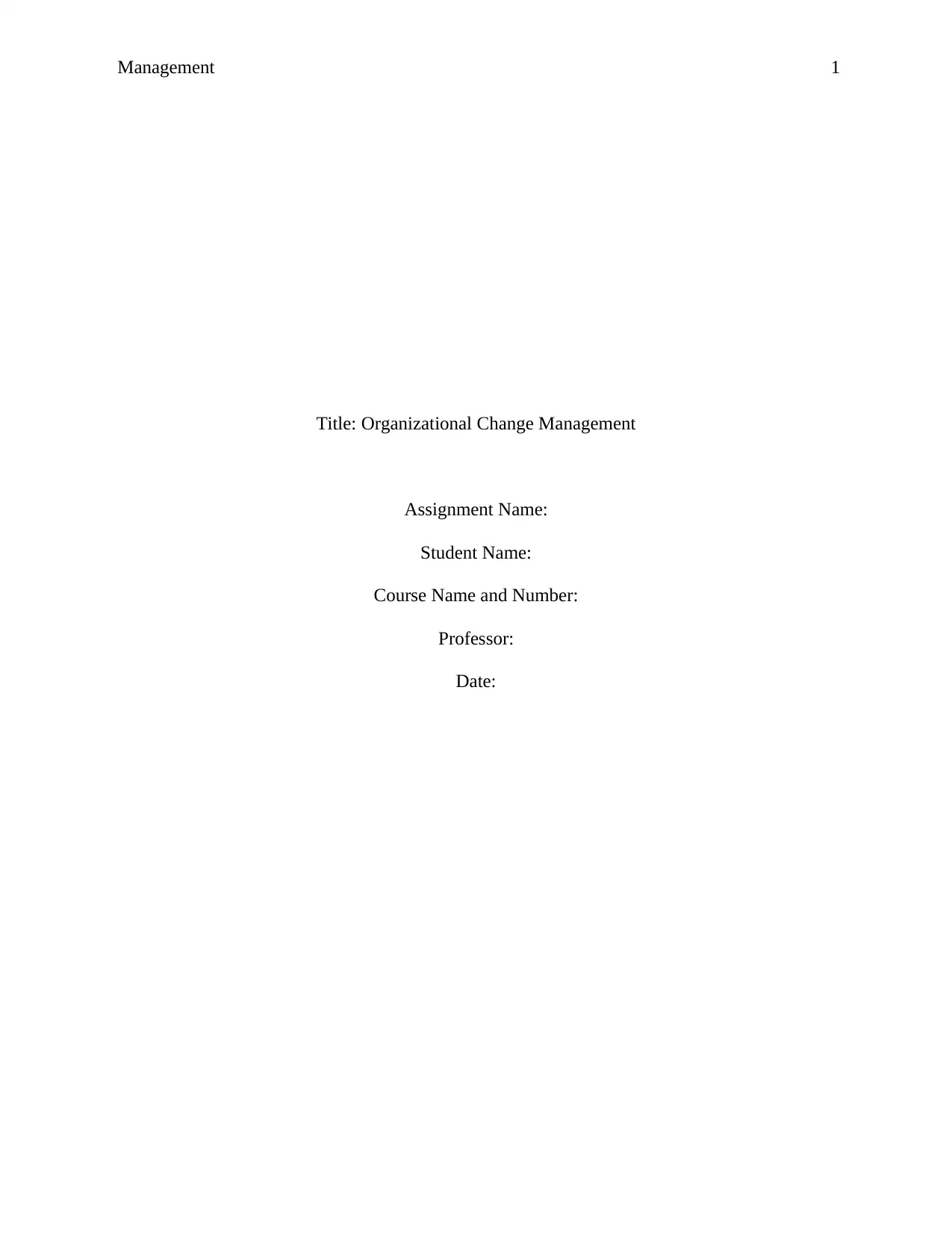
Management 1
Title: Organizational Change Management
Assignment Name:
Student Name:
Course Name and Number:
Professor:
Date:
Title: Organizational Change Management
Assignment Name:
Student Name:
Course Name and Number:
Professor:
Date:
Paraphrase This Document
Need a fresh take? Get an instant paraphrase of this document with our AI Paraphraser
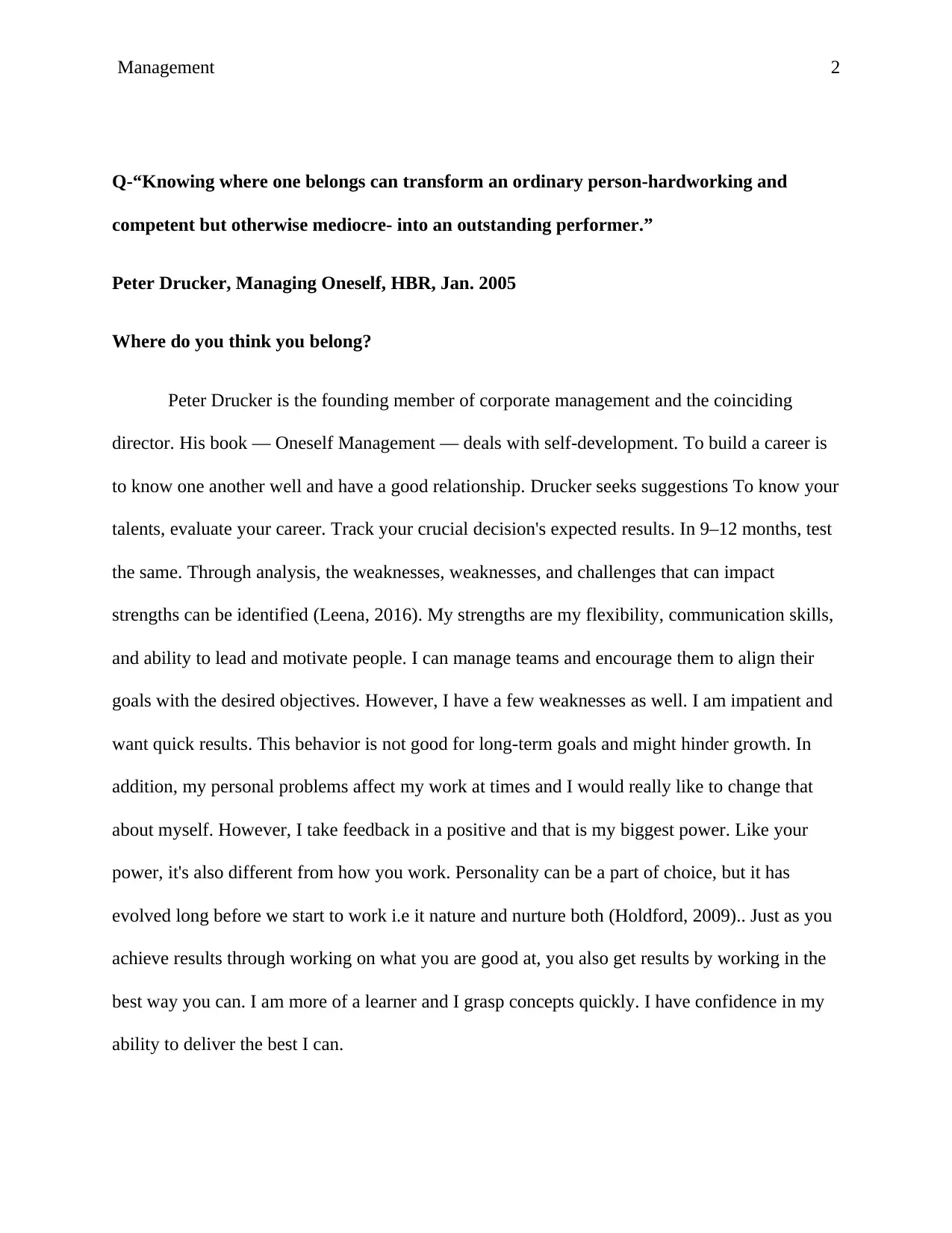
Management 2
Q-“Knowing where one belongs can transform an ordinary person-hardworking and
competent but otherwise mediocre- into an outstanding performer.”
Peter Drucker, Managing Oneself, HBR, Jan. 2005
Where do you think you belong?
Peter Drucker is the founding member of corporate management and the coinciding
director. His book — Oneself Management — deals with self-development. To build a career is
to know one another well and have a good relationship. Drucker seeks suggestions To know your
talents, evaluate your career. Track your crucial decision's expected results. In 9–12 months, test
the same. Through analysis, the weaknesses, weaknesses, and challenges that can impact
strengths can be identified (Leena, 2016). My strengths are my flexibility, communication skills,
and ability to lead and motivate people. I can manage teams and encourage them to align their
goals with the desired objectives. However, I have a few weaknesses as well. I am impatient and
want quick results. This behavior is not good for long-term goals and might hinder growth. In
addition, my personal problems affect my work at times and I would really like to change that
about myself. However, I take feedback in a positive and that is my biggest power. Like your
power, it's also different from how you work. Personality can be a part of choice, but it has
evolved long before we start to work i.e it nature and nurture both (Holdford, 2009).. Just as you
achieve results through working on what you are good at, you also get results by working in the
best way you can. I am more of a learner and I grasp concepts quickly. I have confidence in my
ability to deliver the best I can.
Q-“Knowing where one belongs can transform an ordinary person-hardworking and
competent but otherwise mediocre- into an outstanding performer.”
Peter Drucker, Managing Oneself, HBR, Jan. 2005
Where do you think you belong?
Peter Drucker is the founding member of corporate management and the coinciding
director. His book — Oneself Management — deals with self-development. To build a career is
to know one another well and have a good relationship. Drucker seeks suggestions To know your
talents, evaluate your career. Track your crucial decision's expected results. In 9–12 months, test
the same. Through analysis, the weaknesses, weaknesses, and challenges that can impact
strengths can be identified (Leena, 2016). My strengths are my flexibility, communication skills,
and ability to lead and motivate people. I can manage teams and encourage them to align their
goals with the desired objectives. However, I have a few weaknesses as well. I am impatient and
want quick results. This behavior is not good for long-term goals and might hinder growth. In
addition, my personal problems affect my work at times and I would really like to change that
about myself. However, I take feedback in a positive and that is my biggest power. Like your
power, it's also different from how you work. Personality can be a part of choice, but it has
evolved long before we start to work i.e it nature and nurture both (Holdford, 2009).. Just as you
achieve results through working on what you are good at, you also get results by working in the
best way you can. I am more of a learner and I grasp concepts quickly. I have confidence in my
ability to deliver the best I can.
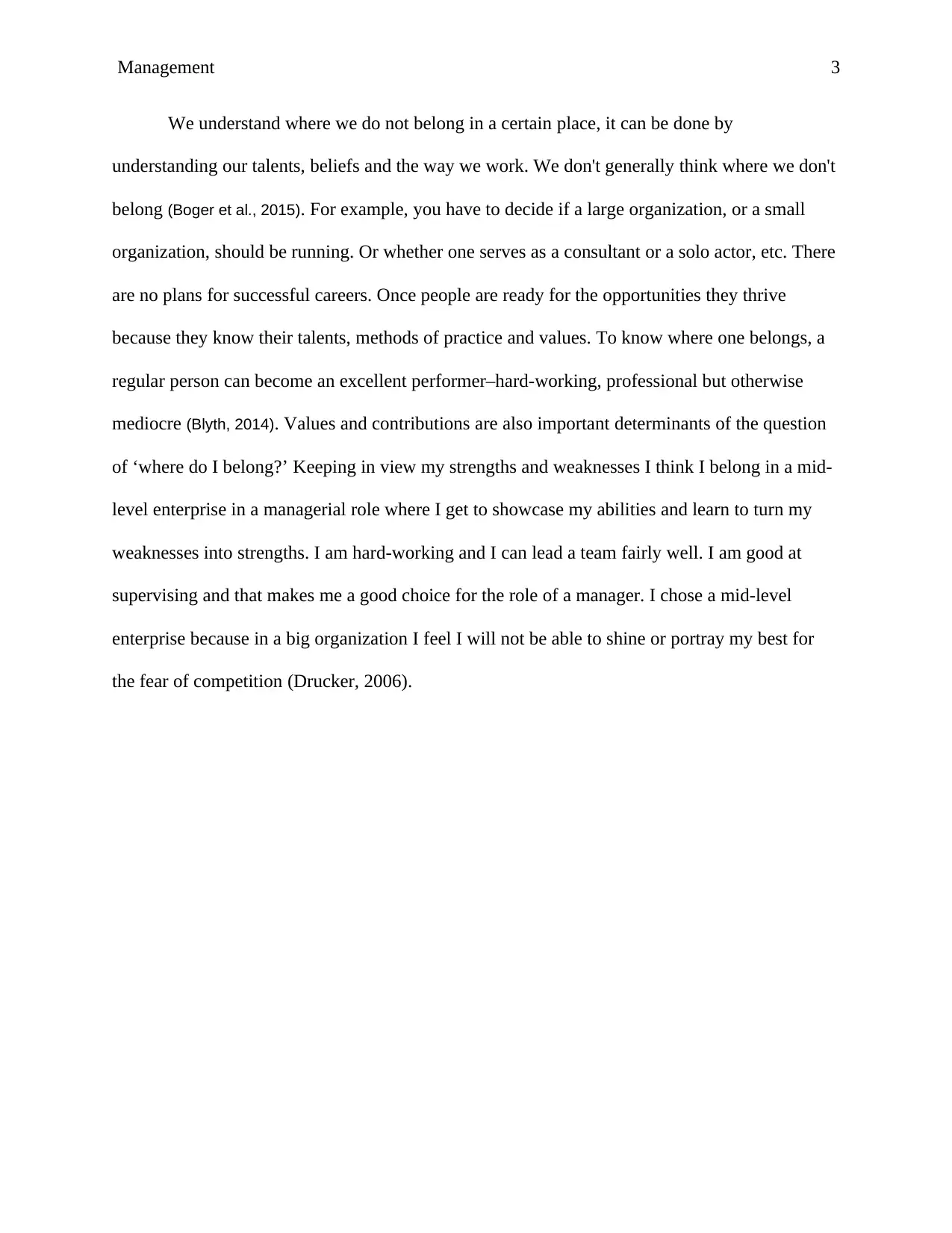
Management 3
We understand where we do not belong in a certain place, it can be done by
understanding our talents, beliefs and the way we work. We don't generally think where we don't
belong (Boger et al., 2015). For example, you have to decide if a large organization, or a small
organization, should be running. Or whether one serves as a consultant or a solo actor, etc. There
are no plans for successful careers. Once people are ready for the opportunities they thrive
because they know their talents, methods of practice and values. To know where one belongs, a
regular person can become an excellent performer–hard-working, professional but otherwise
mediocre (Blyth, 2014). Values and contributions are also important determinants of the question
of ‘where do I belong?’ Keeping in view my strengths and weaknesses I think I belong in a mid-
level enterprise in a managerial role where I get to showcase my abilities and learn to turn my
weaknesses into strengths. I am hard-working and I can lead a team fairly well. I am good at
supervising and that makes me a good choice for the role of a manager. I chose a mid-level
enterprise because in a big organization I feel I will not be able to shine or portray my best for
the fear of competition (Drucker, 2006).
We understand where we do not belong in a certain place, it can be done by
understanding our talents, beliefs and the way we work. We don't generally think where we don't
belong (Boger et al., 2015). For example, you have to decide if a large organization, or a small
organization, should be running. Or whether one serves as a consultant or a solo actor, etc. There
are no plans for successful careers. Once people are ready for the opportunities they thrive
because they know their talents, methods of practice and values. To know where one belongs, a
regular person can become an excellent performer–hard-working, professional but otherwise
mediocre (Blyth, 2014). Values and contributions are also important determinants of the question
of ‘where do I belong?’ Keeping in view my strengths and weaknesses I think I belong in a mid-
level enterprise in a managerial role where I get to showcase my abilities and learn to turn my
weaknesses into strengths. I am hard-working and I can lead a team fairly well. I am good at
supervising and that makes me a good choice for the role of a manager. I chose a mid-level
enterprise because in a big organization I feel I will not be able to shine or portray my best for
the fear of competition (Drucker, 2006).
⊘ This is a preview!⊘
Do you want full access?
Subscribe today to unlock all pages.

Trusted by 1+ million students worldwide
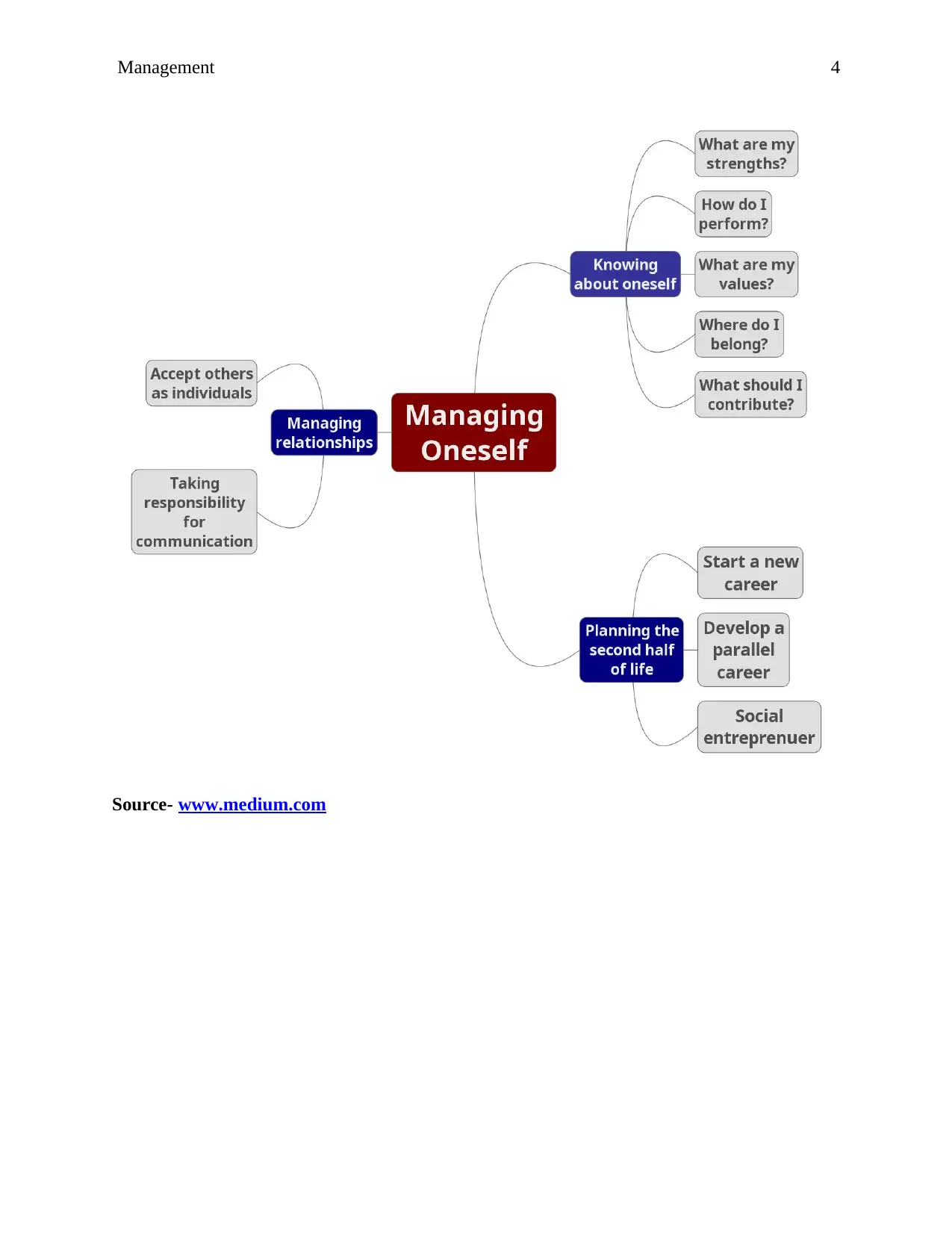
Management 4
Source- www.medium.com
Source- www.medium.com
Paraphrase This Document
Need a fresh take? Get an instant paraphrase of this document with our AI Paraphraser
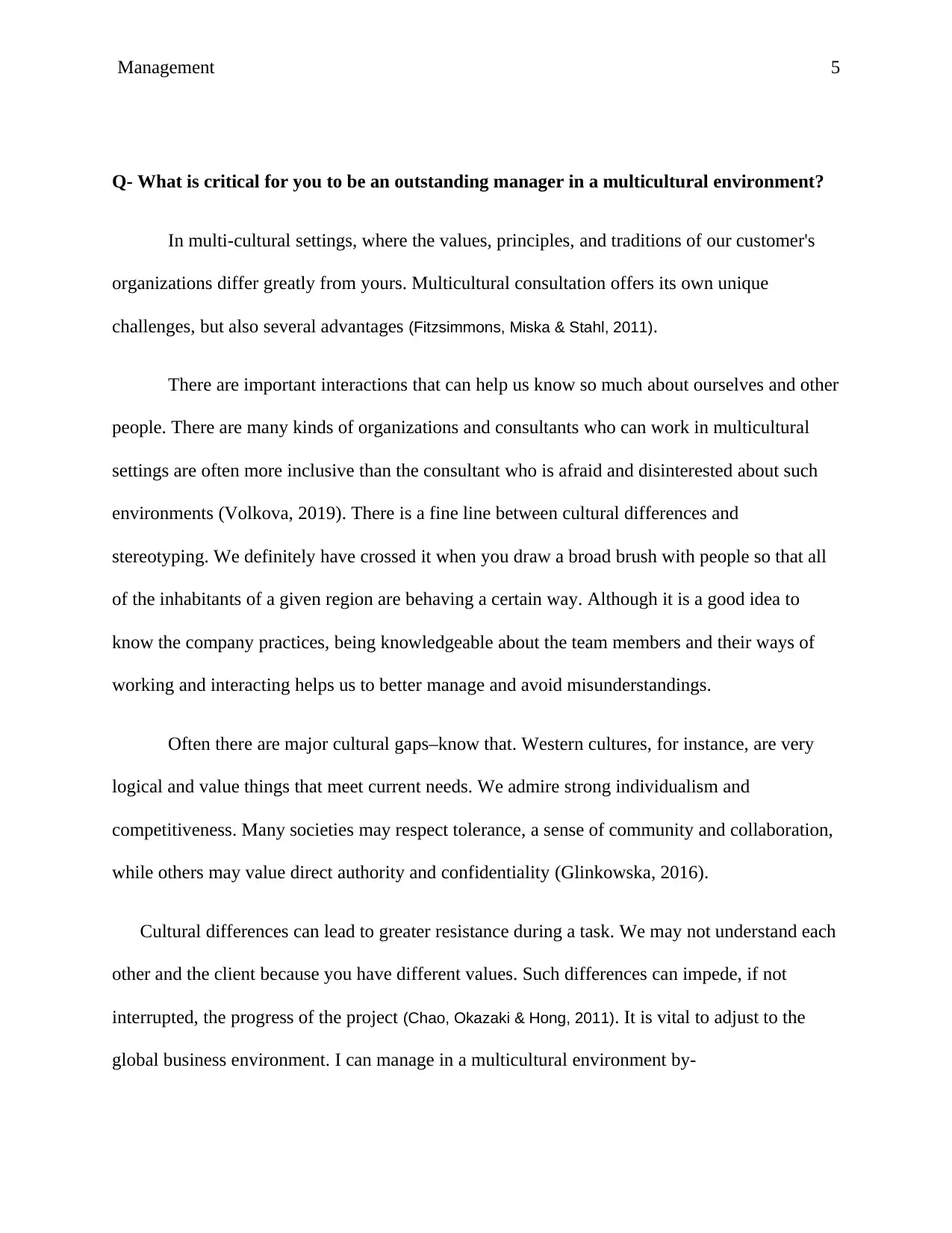
Management 5
Q- What is critical for you to be an outstanding manager in a multicultural environment?
In multi-cultural settings, where the values, principles, and traditions of our customer's
organizations differ greatly from yours. Multicultural consultation offers its own unique
challenges, but also several advantages (Fitzsimmons, Miska & Stahl, 2011).
There are important interactions that can help us know so much about ourselves and other
people. There are many kinds of organizations and consultants who can work in multicultural
settings are often more inclusive than the consultant who is afraid and disinterested about such
environments (Volkova, 2019). There is a fine line between cultural differences and
stereotyping. We definitely have crossed it when you draw a broad brush with people so that all
of the inhabitants of a given region are behaving a certain way. Although it is a good idea to
know the company practices, being knowledgeable about the team members and their ways of
working and interacting helps us to better manage and avoid misunderstandings.
Often there are major cultural gaps–know that. Western cultures, for instance, are very
logical and value things that meet current needs. We admire strong individualism and
competitiveness. Many societies may respect tolerance, a sense of community and collaboration,
while others may value direct authority and confidentiality (Glinkowska, 2016).
Cultural differences can lead to greater resistance during a task. We may not understand each
other and the client because you have different values. Such differences can impede, if not
interrupted, the progress of the project (Chao, Okazaki & Hong, 2011). It is vital to adjust to the
global business environment. I can manage in a multicultural environment by-
Q- What is critical for you to be an outstanding manager in a multicultural environment?
In multi-cultural settings, where the values, principles, and traditions of our customer's
organizations differ greatly from yours. Multicultural consultation offers its own unique
challenges, but also several advantages (Fitzsimmons, Miska & Stahl, 2011).
There are important interactions that can help us know so much about ourselves and other
people. There are many kinds of organizations and consultants who can work in multicultural
settings are often more inclusive than the consultant who is afraid and disinterested about such
environments (Volkova, 2019). There is a fine line between cultural differences and
stereotyping. We definitely have crossed it when you draw a broad brush with people so that all
of the inhabitants of a given region are behaving a certain way. Although it is a good idea to
know the company practices, being knowledgeable about the team members and their ways of
working and interacting helps us to better manage and avoid misunderstandings.
Often there are major cultural gaps–know that. Western cultures, for instance, are very
logical and value things that meet current needs. We admire strong individualism and
competitiveness. Many societies may respect tolerance, a sense of community and collaboration,
while others may value direct authority and confidentiality (Glinkowska, 2016).
Cultural differences can lead to greater resistance during a task. We may not understand each
other and the client because you have different values. Such differences can impede, if not
interrupted, the progress of the project (Chao, Okazaki & Hong, 2011). It is vital to adjust to the
global business environment. I can manage in a multicultural environment by-

Management 6
Knowing my personal preconditions, fashion, tastes, lens, and focus. For effective
consultation in all societies, this is of crucial importance. We make a significant
difference in the organization of the company simply by describing my own purpose and
work style.
Each part of an organization has a culture that is probably unique. For example, the
secretarial personnel may communicate very differently from the way they interact with
managers. Often there are gaps between senior managers and employees of larger
organizations.
Seeking to get someone to appreciate my philosophy and the way I operate in a manner
consistent with the organization's culture. This requirement is not an indication of
weakness or lack of expertise, but demand that fits us and the customer more effectively
(ten Thije & Maier, 2012).
My leadership style is transformational. I think I would encourage people to bring change in
the perspective and accept people from all cultural backgrounds. There shouldn’t be any
prejudice because it can possibly be a hurdle in organizational growth and success. Every person
has a different language, style, culture, etc. It is important to understand the differences and
accept them for the greater good. The diverse teams can be an asset in the global business
scenario where all types of expertise are required. People from different backgrounds can bring
different things to the table.
Knowing my personal preconditions, fashion, tastes, lens, and focus. For effective
consultation in all societies, this is of crucial importance. We make a significant
difference in the organization of the company simply by describing my own purpose and
work style.
Each part of an organization has a culture that is probably unique. For example, the
secretarial personnel may communicate very differently from the way they interact with
managers. Often there are gaps between senior managers and employees of larger
organizations.
Seeking to get someone to appreciate my philosophy and the way I operate in a manner
consistent with the organization's culture. This requirement is not an indication of
weakness or lack of expertise, but demand that fits us and the customer more effectively
(ten Thije & Maier, 2012).
My leadership style is transformational. I think I would encourage people to bring change in
the perspective and accept people from all cultural backgrounds. There shouldn’t be any
prejudice because it can possibly be a hurdle in organizational growth and success. Every person
has a different language, style, culture, etc. It is important to understand the differences and
accept them for the greater good. The diverse teams can be an asset in the global business
scenario where all types of expertise are required. People from different backgrounds can bring
different things to the table.
⊘ This is a preview!⊘
Do you want full access?
Subscribe today to unlock all pages.

Trusted by 1+ million students worldwide
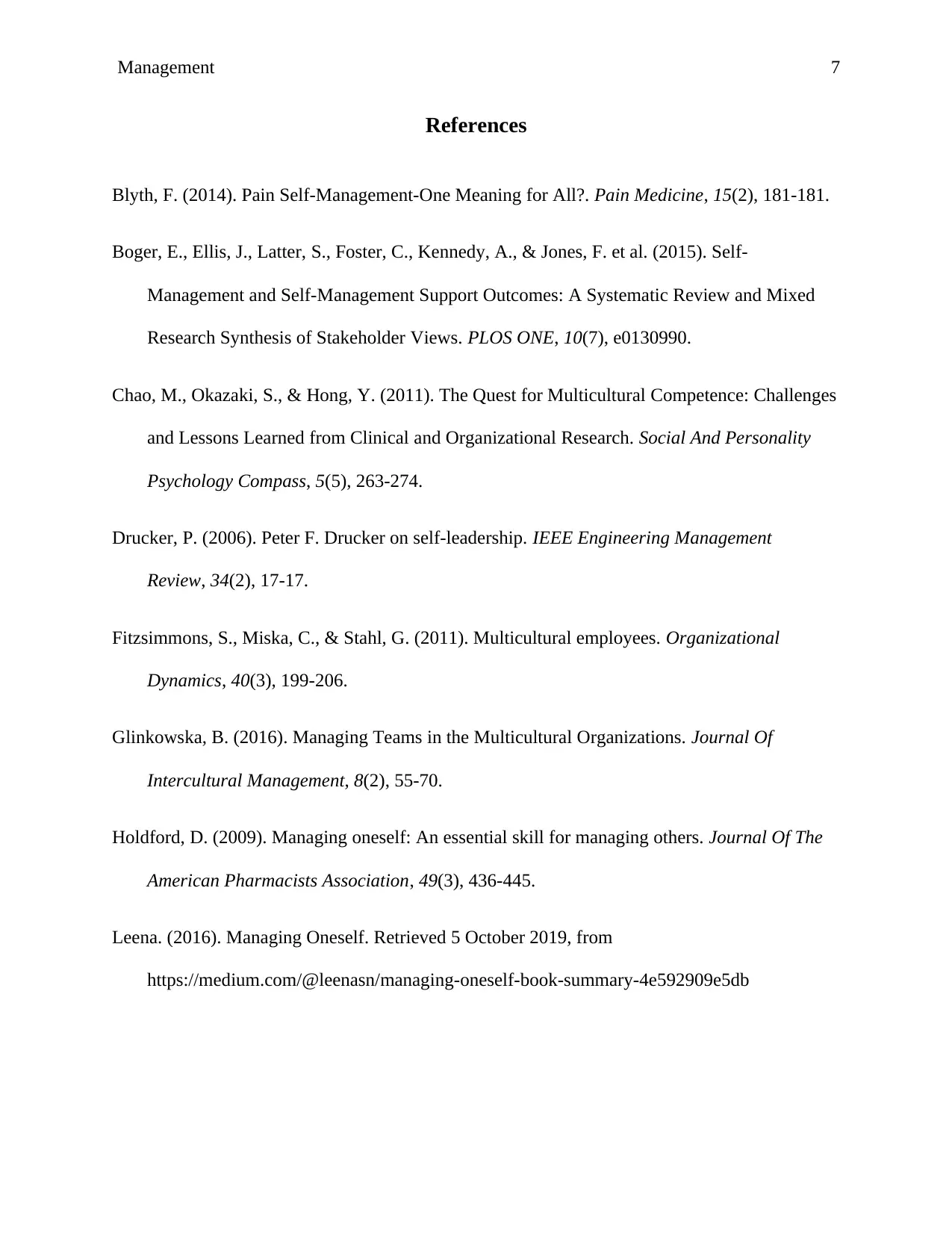
Management 7
References
Blyth, F. (2014). Pain Self-Management-One Meaning for All?. Pain Medicine, 15(2), 181-181.
Boger, E., Ellis, J., Latter, S., Foster, C., Kennedy, A., & Jones, F. et al. (2015). Self-
Management and Self-Management Support Outcomes: A Systematic Review and Mixed
Research Synthesis of Stakeholder Views. PLOS ONE, 10(7), e0130990.
Chao, M., Okazaki, S., & Hong, Y. (2011). The Quest for Multicultural Competence: Challenges
and Lessons Learned from Clinical and Organizational Research. Social And Personality
Psychology Compass, 5(5), 263-274.
Drucker, P. (2006). Peter F. Drucker on self-leadership. IEEE Engineering Management
Review, 34(2), 17-17.
Fitzsimmons, S., Miska, C., & Stahl, G. (2011). Multicultural employees. Organizational
Dynamics, 40(3), 199-206.
Glinkowska, B. (2016). Managing Teams in the Multicultural Organizations. Journal Of
Intercultural Management, 8(2), 55-70.
Holdford, D. (2009). Managing oneself: An essential skill for managing others. Journal Of The
American Pharmacists Association, 49(3), 436-445.
Leena. (2016). Managing Oneself. Retrieved 5 October 2019, from
https://medium.com/@leenasn/managing-oneself-book-summary-4e592909e5db
References
Blyth, F. (2014). Pain Self-Management-One Meaning for All?. Pain Medicine, 15(2), 181-181.
Boger, E., Ellis, J., Latter, S., Foster, C., Kennedy, A., & Jones, F. et al. (2015). Self-
Management and Self-Management Support Outcomes: A Systematic Review and Mixed
Research Synthesis of Stakeholder Views. PLOS ONE, 10(7), e0130990.
Chao, M., Okazaki, S., & Hong, Y. (2011). The Quest for Multicultural Competence: Challenges
and Lessons Learned from Clinical and Organizational Research. Social And Personality
Psychology Compass, 5(5), 263-274.
Drucker, P. (2006). Peter F. Drucker on self-leadership. IEEE Engineering Management
Review, 34(2), 17-17.
Fitzsimmons, S., Miska, C., & Stahl, G. (2011). Multicultural employees. Organizational
Dynamics, 40(3), 199-206.
Glinkowska, B. (2016). Managing Teams in the Multicultural Organizations. Journal Of
Intercultural Management, 8(2), 55-70.
Holdford, D. (2009). Managing oneself: An essential skill for managing others. Journal Of The
American Pharmacists Association, 49(3), 436-445.
Leena. (2016). Managing Oneself. Retrieved 5 October 2019, from
https://medium.com/@leenasn/managing-oneself-book-summary-4e592909e5db
Paraphrase This Document
Need a fresh take? Get an instant paraphrase of this document with our AI Paraphraser

Management 8
ten Thije, J., & Maier, R. (2012). Managing cultural and linguistic diversity in multiple
organisational settings: editorial. Journal Of Multilingual And Multicultural
Development, 33(7), 629-641.
Volkova, V. (2019). Managing organizational communications in the multicultural
environment. Management And Entrepreneurship: Trends Of Development, 2(8), 60-67.
ten Thije, J., & Maier, R. (2012). Managing cultural and linguistic diversity in multiple
organisational settings: editorial. Journal Of Multilingual And Multicultural
Development, 33(7), 629-641.
Volkova, V. (2019). Managing organizational communications in the multicultural
environment. Management And Entrepreneurship: Trends Of Development, 2(8), 60-67.
1 out of 8
Related Documents
Your All-in-One AI-Powered Toolkit for Academic Success.
+13062052269
info@desklib.com
Available 24*7 on WhatsApp / Email
![[object Object]](/_next/static/media/star-bottom.7253800d.svg)
Unlock your academic potential
Copyright © 2020–2025 A2Z Services. All Rights Reserved. Developed and managed by ZUCOL.




